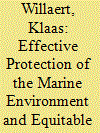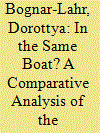|
|
|
Sort Order |
|
|
|
Items / Page
|
|
|
|
|
|
|
| Srl | Item |
| 1 |
ID:
172432


|
|
|
|
|
| Summary/Abstract |
This article examines the practice of the international judicial and arbitral tribunals thus far in delimiting the continental shelf beyond 200 nm, and indicates the trend reflected in the decisions. However, the article disagrees with the critical observation of the tribunals that the delimitation method for the continental shelf beyond 200 nm should follow that within 200 nm. The delimitation of the continental shelf beyond 200 nm is essentially different from the single maritime delimitation within 200 nm, and various methods may be employed in order to achieve an equitable result in a particular case.
|
|
|
|
|
|
|
|
|
|
|
|
|
|
|
|
| 2 |
ID:
172435


|
|
|
|
|
| Summary/Abstract |
The international legal framework with regard to “the Area,” comprising the deep seabed and the subsoil beyond the boundaries of national jurisdiction, has been modified significantly through the years. It was first established by part XI of the United Nations Convention on the Law of the Sea, but the 1994 Implementation Agreement introduced several changes. These general rules and principles are further developed in the “Mining Code,” referring to the comprehensive set of regulations and procedures issued by the International Seabed Authority. The Authority has already produced rules for the first phases of mining activities (prospecting and exploration) in the Area, but has yet to adopt exploitation regulations. Nevertheless, the most recent draft of the exploitation regulations provides a good indication of the current state of play. This article analyzes the current draft of the exploitation regulations, which will shape the future deep seabed mining regime, in order to evaluate whether the relevant provisions are sufficient and effective to attain two prominent goals with regard to the Area: the protection of the marine environment and the equitable sharing of financial and economic benefits. The Law of the Sea Convention indeed states that the resources of the deep seabed are considered common heritage of mankind and prioritizes these objectives. Therefore, the exploitation regulations should strike an appropriate balance between commercial exploitation, environmental protection, and the interests of developing countries. The strengths and weaknesses of this document and the overarching international legal framework are identified and possible corrections are suggested.
|
|
|
|
|
|
|
|
|
|
|
|
|
|
|
|
| 3 |
ID:
172433


|
|
|
|
|
| Summary/Abstract |
In the field of Arctic shipping, Canada and the Russian Federation have enacted extensive unilateral national regulations cognizant of Article 234, UN Convention on the Law of the Sea. On the global level, both states have been important actors in negotiating the International Maritime Organization’s mandatory Polar Code, a legal instrument with implications for regulations at the national level. This article compares and contrasts the approaches, positions, and arguments of Canada and Russia especially regarding national systems to control navigation and vessel-source pollution. The results suggest different emphases stemming from the two states’ political and economic realities and capacities.
|
|
|
|
|
|
|
|
|
|
|
|
|
|
|
|
| 4 |
ID:
172434


|
|
|
|
|
| Summary/Abstract |
The Korea–Japan Joint Development Zone (JDZ) Agreement of 30 January 1974 was one of a number of innovative arrangements for cooperation in an overlapping maritime area. Nevertheless, four decades after its entry into force in 1978, the Agreement has not produced a single drop of oil. In contrast with Korea’s positive view on an oil discovery, Japan has held a negative stance since its concessionaires’ release of rights under the Agreement in 1992. Without Japan’s cooperation, the Agreement is a dead instrument. This article looks, from a Korean perspective, for the solutions whereby the Korea–Japan JDZ Agreement can operate.
|
|
|
|
|
|
|
|
|
|
|
|
|
|
|
|
| 5 |
ID:
172431


|
|
|
|
|
| Summary/Abstract |
Through a normative lens, this article investigates integrated ocean management and the multiple concepts that it involves. Although international law provides legal authority to coastal states to manage their ocean area entitlements, no single legally binding norm specific to integrated ocean management exists. Nevertheless, by combining different internationally recognized sources, this article identifies and discusses two normative concepts applicable in coastal state integrated ocean management. These are (1) the framing of integrated ocean management as a management process and (2) the incorporation of environmental, economic, and social concerns into an ocean management policy.
|
|
|
|
|
|
|
|
|
|
|
|
|
|
|
|
|
|
|
|
|